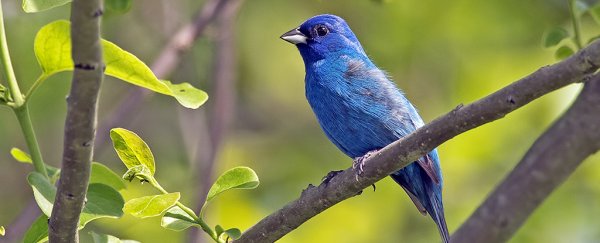From bird feathers to fruit skins, the natural world has two main ways of displaying colour: through pigment substances that provide selective colour absorption, or through structural colour – the use of microscopic structures to control light reflection.
Now scientists have devised a computer model that explains why the brightest matte structural colours in nature are almost always blue and green: because those are the limits of structural colour within the visible spectrum of light.
Besides giving us a better understanding of how the brightest blues and greens are created in the natural world, the research could also be important for developing vibrant, eco-friendly paints and coatings that won't fade over time or release toxic chemicals.
"In addition to their intensity and resistance to fading, a matte paint which uses structural colour would also be far more environmentally-friendly, as toxic dyes and pigments would not be needed," says physicist Gianni Jacucci from the University of Cambridge in the UK.
"However, we first need to understand what the limitations are for recreating these types of colours before any commercial applications are possible."
With structural colour, the nanoscale framework on the surface is what dictates the actual colour itself.
Sometimes – as on peacock feathers, for example – that colour can be iridescent, and shift between colour hues at different angles and under different lights. These are produced by ordered crystalline structures.
 Peacock feathers are a classic example of structural colour. (Tj Holowaychuk/Unsplash)
Peacock feathers are a classic example of structural colour. (Tj Holowaychuk/Unsplash)
With other structures, you get a matte colour that doesn't change arising from disordered structures; in nature this has only been observed in producing blue and green hues. The thrust of the new study was to see whether this was an inherent limitation of said structures.
The new computer model, based on artificial materials called photonic glasses, shows that red is indeed out of the scope of the scattering techniques behind matte structural colours: the long-wavelength region of the visible spectrum can't be easily reflected using the techniques of these microscopic surface structures.
"Because of the complex interplay between single scattering and multiple scattering, and contributions from correlated scattering, we found that in addition to red, yellow and orange can also hardly be reached," says chemist Silvia Vignolini, from the University of Cambridge.
 Plum-throated cotingas display vivid structural matte blues. (redabbott/iNaturalist/CC-BY-NC)
Plum-throated cotingas display vivid structural matte blues. (redabbott/iNaturalist/CC-BY-NC)
This must be why bright matte reds are produced using pigments in nature, rather than structural colour. The team thinks evolution in nature led to different ways of producing red colours, because of the limits of the underlying structures.
Knowing more about how these matte structural colours are created will take us closer to producing paints free from pigments and dyes- a significant step forward in long-lasting, environmentally friendly materials for many applications.
That's still some way off though, and it looks as though a different approach is going to be needed for reds and oranges – other kinds of nanostructures might be able to do the job, after more detailed research into them is carried out, but for now materials scientists are having the same problems as the natural world.
"When we've tried to artificially recreate matte structural colour for reds or oranges, we end up with a poor-quality result, both in terms of saturation and colour purity," says chemist Lukas Schertel, from the University of Cambridge.
The research has been published in PNAS.
